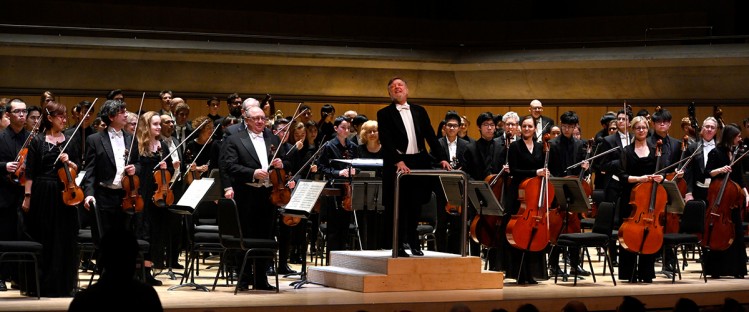This article appears in The WholeNote as part of our collaboration in the Emerging Arts Critics program.
 A fellow concertgoer put it best: The real treat of the Toronto Symphony Orchestra’s (TSO) Brahms and Dvořák program was spending the evening in the company of “local” talent. TSO concertmaster Jonathan Crow and principal cellist Joseph Johnson took the lead as soloists for Brahms’s Double Concerto; the Toronto Symphony Youth Orchestra (TSYO) joined for Morawetz’s Carnival Overture, Op. 2 in their annual “side-by-side” event; and interim artistic director Sir Andrew Davis (who, though not a true local, is certainly an honorary one) conducted. With no guest artists, Roy Thomson Hall felt appropriately intimate and warm – and “Brahms & Dvořák” provided a chance for our company’s own to command full attention in this highly enjoyable, cohesive program.
A fellow concertgoer put it best: The real treat of the Toronto Symphony Orchestra’s (TSO) Brahms and Dvořák program was spending the evening in the company of “local” talent. TSO concertmaster Jonathan Crow and principal cellist Joseph Johnson took the lead as soloists for Brahms’s Double Concerto; the Toronto Symphony Youth Orchestra (TSYO) joined for Morawetz’s Carnival Overture, Op. 2 in their annual “side-by-side” event; and interim artistic director Sir Andrew Davis (who, though not a true local, is certainly an honorary one) conducted. With no guest artists, Roy Thomson Hall felt appropriately intimate and warm – and “Brahms & Dvořák” provided a chance for our company’s own to command full attention in this highly enjoyable, cohesive program.
The night began with Oskar Morawetz’s punchy, 5-minute-long powerhouse Carnival Overture. Morawetz’s score is well-developed and was excellently paced for maximum dramatic effect: I found it impossible not to get swept up in the theatrics of the piece as it veered between bombastic climaxes and dreamy, hushed sequences. Repeated motifs retained the novelty of their initial impact, and each time the cymbal and triangle interrupted with exclamation and insistent ringing it was visceral, producing chills. It was a smart decision to present the Carnival Overture alongside the TSYO, and packing every inch of the stage with musicians – youth members quite literally rubbing shoulders with their TSO counterparts – only amplified the natural show-stopping qualities of the piece. I never found the effect to be too much or overdone: it was truly thrilling.
Brahms’s Concerto in A Minor for Violin, Cello, and Orchestra, Op. 102 took an immediately more serious tone, opening with a bold orchestral theme that transitioned into a stark solo from cellist Joseph Johnson. He patiently drew out phrases and left the sound of pizzicato hanging in the air – one of the night’s more arresting and understated moments. Developing from this unembellished cadenza, the Allegro established a more elaborate, passionate attitude. The Andante movement, with its sweetly lyrical woodwind sections, furthered the Romantic inclinations of the piece, while the Vivace non troppo introduced a contrasting playfulness.
The real highlight of the Double Concerto, unsurprisingly, was the relationship between violin and cello. The two instruments, in the hands of Crow and Johnson, were so complementary it’s hard to believe the pairing was an unconventional and poorly received choice when the piece was first premiered in 1887. Brahms composed the concerto to repair his friendship with violinist Joseph Joachim, a fact that coloured my characterization of the musical relationship onstage. There was little to no sense of rivalry in the cello and violin’s interaction: in the Andante they collaborated in a pleasing, harmonious way, and in the other movements – particularly in the Vivace non troppo – there seemed more banter, a lively back-and-forth that infectiously spread to other sections of the orchestra. When Crow and Johnson attacked their instruments vigorously it was not in competition but with common purpose, to ignite the orchestra and provide momentum. Neither soloist has an ostentatious role here, and their performances integrated seamlessly with the rest of the orchestra.
Dvořák was an admirer and eventual friend of Brahms, who had a strong influence on the slightly younger composer. As the closing performance of Dvořák’s Symphony No. 6 in D Major, Op. 60 began, sweeping melodies quickly reminded me of the two composers’ contemporaneity. But as the first movement developed, it brought a liveliness and energy missing from the more austere Brahms: brass entered with joyful vitality bordering on urgency; woodwinds provided a lovely, lighthearted quality to counterbalance the developing intensity. In the Adagio section, despite impassioned moments, warmth and gentleness won out, as woodwinds mingled with delicate French horns for a serene effect.
Dvořák’s Symphony is known for its third movement, the Scherzo (Furiant): Presto, a symphonic treatment of the vigorous furiant folk dance. The TSO was masterful in its handling of the lively score, displaying strong musicality with accents in all the right places and a beautiful sense of phrasing. Davis accelerated the tempo as the movement raced to its conclusion, ending with a feeling of breathlessness that recalled the Carnival Overture. But the Finale: Allegro con spirito was no letdown after the Scherzo, and the entire orchestra was employed for significant stretches in this exuberant movement. Davis led the orchestra with complete dynamic control and deftness between passages, capping with a jubilant ending.
It was a superb finish to a well-organized program, rich in texture yet full of complementary qualities – and an excellent showcase for the TSO and TSYO’s artistry.
The Toronto Symphony Orchestra presented “Brahms & Dvořák” on February 6, 7 and 9, at Roy Thomson Hall, Toronto.
Dylan Schoenmakers is an editor working in educational publishing. He has previously worked at Harbourfront Centre and the Toronto International Festival of Authors.

